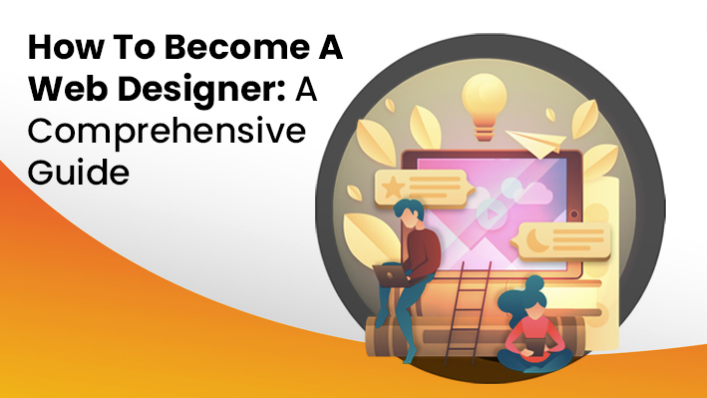When seeking guidance on becoming a web designer, you may come across outdated information, suggesting technologies no longer relevant in the industry. For instance, some articles may advise learning tools like Photoshop, which is no longer a standard requirement. Moreover, you might encounter references to obsolete technologies like Flash.
Compounding the confusion, different authors present conflicting views on the essence of web design. Some define it as a creative domain, focusing on visual aspects specific to websites. Conversely, others view it as a technical skill centered around coding websites using HTML and CSS. As a result, the question remains: what truly defines web design?
What does a web designer do?
A web designer is a professional responsible for creating the visual elements and user interface (UI) of websites. Their primary goal is to design websites that are aesthetically pleasing, user-friendly, and effectively communicate the brand's message or purpose. Web designers work closely with clients, stakeholders, and developers to bring their design concepts to life. Their tasks and responsibilities include:
1. Designing Layouts: Web designers create the overall layout and structure of websites. They decide how the content will be organized and presented, ensuring a logical flow and intuitive navigation for users.
2. Selecting Color Schemes and Typography: Choosing appropriate colors and typography is crucial in creating a cohesive and visually appealing design that aligns with the brand's identity and message.
3. Creating Graphics and Visual Elements: Web designers design and create graphical elements such as logos, icons, buttons, and banners to enhance the website's visual appeal and usability.
4. Designing User Interfaces (UI): Web designers focus on crafting intuitive and user-friendly UIs that make it easy for visitors to interact with the website and find the information they need.
5. Implementing Responsive Design: With the prevalence of mobile devices, web designers ensure that websites are responsive, adapting to different screen sizes and devices to provide an optimal user experience.
6. Collaborating with Developers: Web designers work closely with Front End developers to ensure that their design concepts are implemented accurately and efficiently in the final website.
7. Incorporating User Experience (UX) Design: While web designers focus on the visual aspects, they also consider user experience. They aim to design websites that are easy to navigate, user-friendly, and meet the needs of the target audience.
8. Conducting Research: Web designers may conduct user research and usability testing to gather feedback and insights, enabling them to make data-driven design decisions.
9. Staying Updated with Design Trends: Web designers continuously keep abreast of the latest design trends, technologies, and best practices to create modern and innovative websites.
10. Maintaining and Updating Designs: After the website is launched, web designers may be involved in updating and maintaining the design to keep it relevant and up-to-date.
Web designers use various tools and software, such as Adobe Photoshop, Adobe XD, Sketch, Figma, and more, to create wireframes, mockups, and prototypes. Their role is critical in crafting the visual identity and user experience that ultimately contribute to the success of a website or web application.
Web design is a creative and dynamic field that involves creating visually appealing and user-friendly websites. As the internet continues to play an essential role in our daily lives, the demand for skilled web designers is on the rise. If you aspire to become a web designer, this comprehensive guide will take you through the steps, skills, and tools you need to master to build a successful career in web design.
1. Understand the Role of a Web Designer:
Before embarking on your web design journey, it's crucial to understand the role of a web designer. Web designers are responsible for designing the user interface (UI) and user experience (UX) of websites. They create layouts, select color schemes, choose typography, and design graphical elements to ensure that websites are visually appealing and easy to navigate. Web designers collaborate with clients, developers, and other stakeholders to bring their vision to life.
2. Learn the Fundamentals of Design:
A strong foundation in design principles is essential for a successful web design career. Start by learning about color theory, typography, layout, and composition. Understand the psychology of design and how it influences user behavior. Familiarize yourself with design terminology and concepts such as contrast, balance, hierarchy, and white space. Taking online design courses or reading design books can be a great way to gain this knowledge.
3. Master HTML and CSS:
HTML (Hypertext Markup Language) and CSS (Cascading Style Sheets) are the building blocks of web design. HTML provides the structure of a website, while CSS controls its presentation and layout. Learn how to create HTML documents, use semantic elements, and structure content effectively. Additionally, master CSS to control fonts, colors, spacing, and responsive layouts. Understanding how HTML and CSS work together is essential for every web designer.
4. Get Familiar with Web Design Software:
To bring your designs to life, you'll need to work with design software. Adobe Photoshop, Adobe XD, Sketch, and Figma are popular choices among web designers. Familiarize yourself with these tools and learn how to create wireframes, mockups, and prototypes. Practice designing various web elements, such as buttons, icons, and banners, to hone your skills.
5. Learn Responsive Design:
In today's mobile-centric world, responsive design is a must. Responsive design ensures that websites adapt and display properly on different devices and screen sizes. Learn about media queries, flexible grids, and responsive images to create websites that look great on desktops, tablets, and smartphones.
6. Study User Experience (UX) Design:
User experience is crucial in web design. UX design focuses on creating websites that are intuitive, easy to use, and meet users' needs. Understand user research techniques, usability testing, and information architecture. Learn how to create user personas and design user flows to improve the overall user experience of websites.
7. Build a Portfolio:
A portfolio is a showcase of your best work and is essential for getting noticed by potential clients or employers. Start building your portfolio by working on personal projects or offering your services to friends or local businesses. Include a diverse range of projects that highlight your skills and creativity. As you gain more experience, update and refine your portfolio regularly.
8. Stay Updated with Design Trends:
Web design is an ever-evolving field, and staying updated with the latest design trends is crucial. Follow design blogs, websites, and social media channels to keep abreast of current design trends, tools, and techniques. Attend design conferences and webinars to learn from industry experts and network with other professionals.
9. Collaborate and Seek Feedback:
Collaborating with other designers, developers, and clients can enhance your skills and expose you to different perspectives. Seek feedback on your work from peers, mentors, or online communities. Constructive feedback will help you identify areas for improvement and refine your designs. Collaborating with web design specific platforms such as Web Designer Hub or others can help you to build industry connections as well as exposure to your work.
10. Consider Specializing:
As you gain more experience, consider specializing in a particular niche of web design that aligns with your interests and strengths. Specializations like e-commerce design, mobile app design, or UI/UX design can make you a sought-after professional in your chosen area.
Conclusion:
Becoming a web designer requires dedication, continuous learning, and a passion for creating captivating digital experiences. Start by building a strong foundation in design principles and mastering HTML and CSS. Familiarize yourself with web design software and learn responsive design techniques. Study user experience design to create websites that are user-friendly and intuitive. Build a portfolio to showcase your skills and stay updated with design trends to remain relevant in the ever-changing web design industry. With practice, perseverance, and a commitment to improvement, you can embark on a successful career as a web designer.
Looking to enhance your UI/UX Design skills? Join techaedu now for top-notch courses! Learn to create captivating user interfaces, design seamless user experiences, and master the art of user-centric web and app design. Our UI/UX design courses offer hands-on projects and real-world applications to ensure you stay ahead in the rapidly evolving design industry. Whether you're a beginner or an experienced designer, techaedu has the right courses for you. Get certified, boost your career, and unleash your creative potential in UI/UX Design. Don't miss this opportunity. Enroll now at techaedu and take your design career to new heights!





Leave a reply